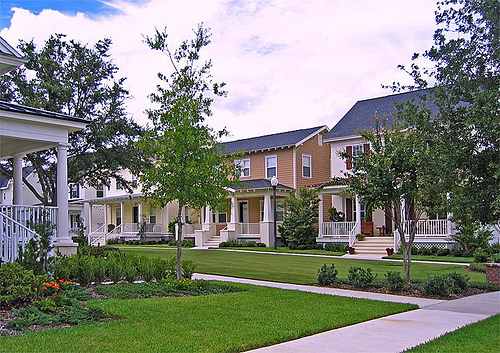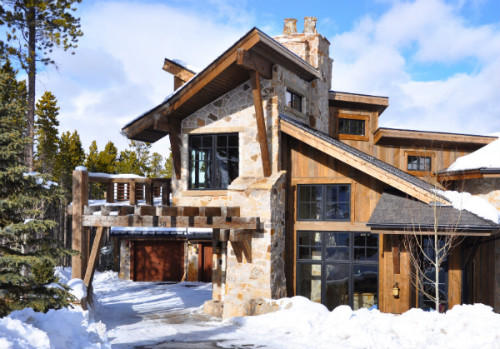As the 2010/11 ski season nears its end and Earth Day 2011 celebrations begin, CSCUSA is highlighting resort environmental efforts. By implementing new means of generating and conserving energy, sourcing more sustainable ways of construction and snowmaking, and making it a priority to give back to their communities, CSCUSA resorts are leading the way in protecting one of Colorado ski industry’s most valuable assets for future generations of outdoor enthusiasts.
Colorado Ski Country USA (CSCUSA) is the global voice of Colorado’s ski industry and represents the world’s premiere ski destinations. With 22 member resorts, CSCUSA encompasses 28,791 skiable acres, 3,623 snowmaking acres, 2,328ft average vertical rise, and 1,749 trails. Resorts offer a wide variety of terrain by utilizing the natural landscape of Colorado’s Rocky Mountains, hence, CSCUSA resorts are making it their duty to be good stewards of the environment in which we ski.
Alternative Energy
While resorts are long-standing proponents and users of alternative energy, many resorts are adopting new wind and solar energy sources to power their on and off-mountain operations while always exploring new forms of alternative energy and energy efficiencies.
In effect since 1997, AreaNet has expanded each year to now control snow melt systems with moisture and temperature sensors, ensuring that heat will not be used unless it is wet and below freezing at Snoasis, Sunspot, Mary Jane, the Village Cabriolet lift, the Private Lesson Center and Zephyr Mountain Lodge. AreaNet also has some control over gas appliances and heat as well as shutting down snow-making equipment when temperatures are too warm for optimum snow production.
• Winter Park installed a small wind turbine at the top of Parsenn Bowl to provide power to the lift shack. The turbine offsets energy consumption and increases lift operation efficiency. Also, Winter Park’s electrical foreman designed and built hardware and software to create a resort-wide automatically controlled system – AreaNet – that shuts down heat to lift shacks and lift motor rooms when not needed.
• Copper Mountain harnesses solar power with photovoltaic panels that line the south-facing roof of the Transportation Center in the Alpine Lot. The 4.2 kW solar installation provides a portion of the electricity for the building. The resort is also working to retrofit lighting fixtures with more energy-efficient light bulbs.
• Through solar energy, Aspen/Snowmass generates a total of 171.2kW with 147kW coming from a solar array installed at the Colorado Rocky Mountain School (CRMS) in Carbondale. The $1 million system sits on one-half acre of ranchland owned by the high school.
The electricity generated by the CRMS solar array powers the school’s science building, with excess energy fed into the town of Carbondale’s power grid. Annually, the installation will produce 200,000kWh (enough power for 20 average American homes) and keep 400,000 lbs of carbon dioxide out of the air each year.
Along with solar arrays, Aspen/Snowmass has explored alternative energy using spring runoff. The resort installed a 115kW micro-Hydro plant at Snowmass that produces power from melting snow. The golf clubhouse system reduces natural gas consumption by 2/3.
Several other facilities around Aspen also make use of solar energy including a 2.3kW solar installation at Aspen Highlands ski patrol headquarters; a 10.6 kW solar installation at Thunder River Lodge; an employee housing complex in Carbondale; a 5kW array at The Little Nell hotel; a 4.3kW array at the Snowmass Club; and a 2.0 kW array at the Sundeck atop Aspen Mountain.
• Wolf Creek currently purchases 100 percent of its power usage from a green power supplier, and has been recognized by the US Forest Service for its commitment to alternative energy.
• At Monarch Mountain, the majority of lighting is done with energy efficient light bulbs, with motion-sensor lighting in some areas.
• Crested Butte Mountain Resort (CBMR) completed a full energy inventory of its Mountain Operations in 2008. The inventory included lifts, snowmaking, facilities and vehicles. As a charter member of the Colorado Industrial Energy Challenge, CBMR set the goal to reduce its overall energy consumption by 2 percent per year. Since 2008, through conservation and management, the resort has reduced electrical use by 17.15 percent, fuels by 28.5 percent, natural gas consumption by 47.2 percent and pumped 8.3 percent less water, exceeding the resort’s goals. Part of this reduction resulted from relocating the resort’s park and pipe area to a new location that requires less energy to pump water and air.
Through its energy efficient measures, CBMR is running a more cost-effective business and has reduced carbon emissions by more than 11 percent.
Additionally, CBMR has installed timers on the heaters in its lift shacks, enabling employees to be more comfortable while also significantly reducing energy use.
Renewable Energy Credits
Renewable Energy Credits (RECs) are another method many resorts use to offset energy consumption. Each REC represents one megawatt hour of electricity as generated from a certified renewable energy source. Many of CSCUSA’s member resorts are using RECs to offset their energy use, especially in areas where alternative energy is not readily available.
• Wolf Creek offsets 100 percent of year-round operations with RECs, while Powderhorn offsets two of its three lifts with RECs and is planning to purchase RECs to offset more of the resort’s energy use in years to come. Steamboat’s RECs offset three percent of the resort’s total electricity requirements, while Telluride‘s RECs offset 1,000,000 kWh of electricity use each year.
• Winter Park’s RECs offset the Panoramic Express, Eagle Wind, Super Gauge Express and Village Cabriolet lifts, which combined equal 6.4 percent of the resort’s total electrical usage.
Construction
Through the Leadership in Energy and Environmental Design, or the LEED Certification System, and other green building initiatives, many CSCUSA resorts are dedicating themselves to sustainable and environmentally-responsible development.
• Aspen/Snowmass has instituted a Green Building Policy that aims to reduce the impact of building and development by adhering to green building guidelines and participating in the LEED certification program. The Snowmass Golf Clubhouse, Sam’s Restaurant, and the Aspen Holiday House Employee Housing are all LEED certified buildings.
• At Copper Mountain, the Woodward at Copper action sports facility was awarded a Green Globe third-party certification for green building practices and design. The Woodward building features energy-efficient heating and cooling systems, low volatile organic compounds (VOCs), and energy-efficient lighting.
• Over the past two years, Purgatory implemented conservation measures as it added terrain with the Legends expansion and created The Ambassadors Glade, which further increased the resort’s skiable acreage and improved forest health and wildlife habitat through a selective tree clearing and thinning process.
Purgatory also constructed the half-pipe and other terrain park features out of dirt and utilized a new technique and product called biochar, which helps store carbon in the ground, improves water quality and increase soil fertility for forest rehabilitation.
Land Management
Many resorts have developed land management programs that protect vegetation from snow making/contouring equipment and maintain maximum vegetation cover.
• Steamboat has programs for slash management to prevent run-off and land degradation, re-vegetation for natural grasses and plants, and habitat management for native species.
• Sunlight developed a vegetation management program to balance maximum forest cover with safe and varied terrain.
• Telluride is also working on a vegetation cover analysis to increase on-mountain vegetation while maximizing space on the slopes.
• Winter Park continues to work with the United States Forest Service on its award winning Pine-Beetle Mitigation.
Recycling, etc.
Nearly all of CSCUSA’s resorts have recycling and re-use programs in place that reduce waste and increase awareness of the environment.
• At Crested Butte, the resort recycled more than 50 percent of solid waste products in 2010 and set a goal to recycle more than 65 percent in 2011. Additionally, Crested Butte uses Green Seal Products in its operations and lodging division as part of the Green Purchasing Program.
• Recycling and composting are top priority at Arapahoe Basin. A recycling policy and waste reduction guidelines were implemented recently and have had a major impact on the amount of recycling and compost being diverted from the landfill. Arapahoe Basin composts in the kitchens of both restaurants, at all after-hour events, and with its Snowsports School lunch program. The resort also allows its employees to bring all compostables from home. To date Arapahoe Basin has diverted approximately 20 tons of compost from the landfill.
• Monarch Mountain recycles everything possible at the resort, from office materials to food and beverage utensils. Monarch also re-processes used oil and grease for re-use.
• Wolf Creek recycles kitchen oil, equipment oil, steel, aluminum, cardboard, paper, batteries, uniforms, ink cartridges, office equipment, and phone books.
• Copper Mountain increases its resort-wide recycling program each year. The Copper Conference Center has a pilot composting program to encourage staff to compost all food scraps.
• Powderhorn recycles everything including glass, plastics, aluminum, office paper, newspaper, cardboard, uniforms, printer cartridges, oil, skis, and some metals. The Fleet Maintenance at Powderhorn installed a used-oil burner to reduce propane use and eliminate sending waste oil to third parties for disposal. Powderhorn also gives old rental skis to a local carpenter who uses them to manufacture deck chairs and benches.
• Silverton Mountain follows the ‘reduce, reuse and recycle’ mantra in nearly every aspect of its operations. The Base Lodge was donated by the town of Silverton, the equipment facility is run out of a used school bus, the mountain’s only lift was purchased from Mammoth Mountain in California, and all mountain vehicles, radios, furnishings, carpeting, bar equipment, ski patrol toboggans, and ropes were donated as well. As a result, Silverton produces very little waste.
• Purgatory has a resort-wide recycling program that encourages all guests and employees to recycle. Purgatory recycles all construction material and is home to the North County Recycling Center where residents of North County can bring their recyclables
• Telluride’s latest “reduce, reuse and recycle” efforts include resort restaurants using natural sugar cane take-out containers and printing receipts by request only, saving approximately 2,000 receipts daily. Ski school utilizes paperless check-out systems, saving 10,000 triplicate forms. The resort reduces paper-usage by digitalizing all legal files and has developed a paperless database.
Recycling at Telluride is available at all guest service kiosks, and at the snowcat fuel island. The maintenance department uses bulk chemicals having phased out aerosol cans, and has transitioned to cloth rags for cleaning instead of paper towels. One of Telluride’s more creative initiatives was the purchase of a waste oil heater. This heater burns all food and beverage fryer oils as well as most maintenance shop oils including hydraulic fluids, used motor oils, and more, saving heating bills and hazmat hauling fees. Skiers and riders will also notice Telluride’s trail sign posts, made from old rental shop skis.
• Steamboat’s award winning Zero Waste Initiative eliminates the amount of trash sent to landfills with the goal of producing zero waste in the future. The Initiative utilizes composting, in addition to recycling and reusing. All mountain restaurants and outlets are using biodegradable and compostable products wherever available and eliminated trash by utilizing reusable plates and silverware. Unique recycling efforts include coffee grounds, milk jugs to make patio furniture and old signs and banners turned into messenger bags and totes.
• To better educate its staff and guests about Winter Park Resort’s environmental initiatives, the resort developed Connexion – an umbrella brand with a distinct look placed throughout the resort on various recycling stations and displayed on signage on the mountain. Connexion’s goal is to inform, involve and educate resort employees, guests and the community about the environment in which they work and play. The program includes energy reduction efforts with the purchase of RECs, the utilization of single-use items made from biodegradable resources, and an expanded recycling program for guests and staff.
Winter Park Resort’s food and beverage department continues to lead the resort’s recycling efforts with restaurants currently expanding the amount of reusable items to completely eliminate waste or by using single-use, environmentally-friendly and completely compostable products like cups, plates, bowls, and cutlery, all made from corn, sugar cane, and potato starch. Winter Park’s resort wide efforts help divert 43 percent of its waste from landfills.
Snowmaking & Snow Equipment
By using more efficient snowmaking machines, as new snowmaking and upgrades to existing snowmaking are brought online, many CSCUSA resorts are saving rather than spending energy when it comes to making snow and slope maintenance.
• Combining efforts of added snowmaking coverage with state-of-the-art energy efficient guns and constructing its half-pipe and other terrain park features out of dirt, Purgatory was able to reduce water and energy consumption through snowmaking and conserve 190,000 gallons of water during the 2010-11 season.
In addition, new snowcats were purchased for the season, reducing fuel usage and saving more than 14,000 gallons of fuel, greatly reducing Purgatory’s carbon footprint.
• At Arapahoe Basin, an airless snowmaking system requires 20 percent less energy than traditional equipment, and Eldora continues to improve the efficiency of its snowmaking system, therefore lowering its energy demand. Steamboat uses a similar technology, with nearly nine miles of pipe installed over the past few seasons.
• Aspen/Snowmass has begun using a dirt-based superpipe at Buttermilk to reduce the amount of snowmaking necessary in the winter. The dirt pipe saves more than $15,000 in electricity and 4 million gallons of water each year.
• At Telluride, biodiesel fuel is used in most of the on-mountain machinery, including snowcats, trail crew utility machines and golf course utility vehicles.
• Copper has also been able to reduce its snowmobile fuel consumption by 40 percent in the past few years.
• Crested Butte made energy reductions by investing in new Low Energy HKD snow guns that were awarded to the resort as part of the 2010 Sustainable Slopes program. Crested Butte also has a sophisticated tracking system for peak energy loads. When temperatures are below 15 degrees, employees shut off the compressed air in the tower and run water instead, saving large amounts of energy.
Alternative Public Transportation
The emergence of energy efficient public transportation has made a positive impact on resort transportation systems while providing incentives and rewards for guests and employees that use the systems.
• In support of the benefits of public transportation and carpooling, Copper Mountain offers carpooling incentives to guests who arrive with four or more people in their vehicle. On select weekends, Copper offers premier parking in the Alpine Lot for those who carpool.
• Durango’s carpool program provides incentives of $7 – 10 per day to employees who carpool and includes free, close-in parking and a Carpool-only Parking Lot for cars with three or more people.
• The Summit Stage bus runs from Breckenridge to Arapahoe Basin, stopping at multiple locations in-between. The Summit Stage reports that riding the bus saves 20 pounds of CO2 emissions per day.
• Employees and guests at Arapahoe Basin who carpool to the ski area are rewarded for using public transit with discounted lift ticket rates.
• Environmental efforts of Eldora include public transportation advocacy. Eldora is the only Front Range ski resort accessible via Denver’s Regional Transportation District (RTD) bus route.
• Monarch Mountain operates a daily shuttle for employees between Poncha Springs, Salida, and the mountain. On Saturdays, Monarch also offers a guest shuttle from Salida through the Parks and Recreation Department.
• Powderhorn also promotes alternative transportation with a town shuttle from Grand Junction to Powderhorn on weekends and holidays.
• Each season, millions of passengers use Aspen/Snowmass’ alternative transportation – the Roaring Fork Transit Authority (RFTA). The RFTA operates a number of Hybrid Buses and has increased the percentage of Bio-Diesel buses. RFTA provides an extensive commuter bus services within the Roaring Fork Valley between Aspen and Glenwood Springs.
• Steamboat’s free busses, used for employee and guest transportation to and from parking, are alternative-transportation vehicles, which reduce the vehicle miles traveled and ultimately reduce emissions and traffic congestion.
• At Sunlight, the Employee Transit System provides more than 100,000 employee passenger miles per season. The resort’s guest Park and Ride Program provides scheduled ride service from the Sunlight Ski and Bike Shop in Glenwood Springs to the resort.
Corporate Community
While CSCUSA resorts are known for providing world class skiing, they also give generously to local community programs, federal initiatives, and environmental partners.
• Environmental partnerships are a large part of Telluride’s environmental program. The resort is aligned with the United States Forest Service, United States Environmental Protection Agency, Colorado Division of Wildlife, US Fish and Wildlife Service, Army Corp. of Engineers, Sheep Mountain Alliance, San Juan Fens Partnership, Bonneville Environmental Foundation, Colorado Department Of Transportation, New Community Coalition Sustainability Team, Clif Bar, Chaco, and Fairfield Resorts.
• At Aspen/Snowmass, environmental partnerships go beyond the corporate realm with more than half of Aspen/Snowmass employees contributing a dollar per week to the Environment Foundation, a nonprofit governed and run by employees. Employee contributions are matched by the Aspen Community Foundation, and again by the Aspen Skiing Company Family Fund. Donations go to local environmental causes such as clean air and water programs, trail maintenance and energy efficiency initiatives. The foundation has donated $1.2 million to various groups in the Roaring Fork Valley since its inception in 1997.
• Arapahoe Basin offers season pass holders a chance to join the resort’s Snow Huggers Club. The Snow Huggers Club offers its members exclusive discounts for Arapahoe Basin, including a 1/2 price lift ticket, rental or lesson, and discounts at Arapahoe Sports and the Legends Cafe or Black Mountain Lodge. All the proceeds are donated to the High Country Conservation Center, a non-profit organization dedicated to minimizing waste and conserving resources in Summit County and surrounding areas.
• Guests at restaurants and retail operations at Crested Butte have the opportunity to assure open space in the upper Gunnison Valley. Butte 66, The Ice Bar, Paradise Warming Hut, On Mountain Basics, the General Store, The Woodstone Grille, The Woodstone Deli, The Grand Lodge Gift Shop, the 9280 Restaurant, and Elevation Station are all participants in the 1% for Open Space program. With purchases at these participating locations, customers are given the option to donate one percent of the services provided to them to 1% for Open Space.
• Local forest conservation plays a large role in Copper’s Environmental Program. Copper has partnered with the National Forest Foundation (NFF) to fund local conservation projects and has committed to donate funds to the Friends of the Dillon Ranger District (FDRD), a local nonprofit partner of the United States Forest Service (USFS). Copper will continue to raise funds through the Ski Area Contribution Program, support local conservation groups, including FDRD, and maintain the local Wheeler Lakes Trail through the Adopt-a-Trail program.
Once collected, the program grants this money to requesting organizations for the protection of open space in Gunnison County. Through these non-profits, land has been preserved on the Woods Walk, the Lower Loop, the Rec Path, Washington Gulch, along the Slate River, and Kebler Pass, among others. Crested Butte has also donated four percent of its Prospect land sales to the Crested Butte Land Trust, a Crested Butte non-profit that works to permanently preserve open space land in the area.
• Steamboat’s resume of community environmental outreach projects includes a joint project with the U.S. Forest Service and the Boy Scouts of America, in which more than 800 spruce seedlings were planted at the ski area’s kids-only winter adventure park, Rough Rider Basin. Steamboat also worked with the Strawberry Park Elementary School rehabilitation program at Butcherknife Creek and helped with re-grading and re-vegetating stream banks, as well as improving habitat for fish and wildlife.
Steamboat’s annual spring on-mountain project day, now in its 19th year, has been organized with more than 100 resort employees working on projects, gathering litter and other materials from across the area. On average, nearly 100 gallons of trash is removed or recycled from the resort that day.
Additionally, the resort makes an annual contribution of $75,000 for recreational projects including parks, beautification and recreation. In addition, over the past two decades, more than $1.7 million has gone toward community projects. Since its inaugural year in 2004, the Ski Corp. Employee Environmental Fund has granted nearly $200,000 to 42 projects representing a variety of nonprofit organizations across the Yampa Valley.
Industry Awards
CSCUSA resorts are continually recognized for their efforts in environmentalism and sustainability.
• Arapahoe Basin was voted #3 in Top Ten Green Ski Resorts by SkiNet.com in April 2009. In the same month the resort’s environmental manager, Sha Miklas, was awarded Essential Earthy Employee by High Country Conservation Center. In past years, Arapahoe Basin has also received multiple NSAA Silver Eagle Awards. In 2008, the resort won the award for Excellence in Visual Impacts, and in 2005 won the award for Excellence in Water Conservation.
• In 2010, Purgatory received the Clif Bar Silver Eagle Award for Excellence in Fish and Wildlife Habitat Protection, one of the ski industry’s highest environmental honors. Purgatory was recognized for its comprehensive efforts in planning and implementing the Legends expansion project, which increased the resort’s total skiable acreage by 10 percent and improved forest health and wildlife habitat.
• Recent accolades for Aspen/Snowmass include, the 2008 Clif Bar Silver Eagle Award for Environmental Education, the 2008 Snowmass Club Golf Course Audubon Cooperative Sanctuary Program Certification, the 2008 NSAA Best Overall Marketing Programming (resorts with 500,000+ skier visits – recognizing Aspen/Snowmass’ compact fluorescent distribution program), and the 2008 City of Aspen ZGreen Membership – recognizing exemplary environmental stewardship.
• Telluride’s recognition for excellent environmental initiatives includes the 2005 NSAA Silver Eagle Award for Protection of Fish and Wildlife Habitat and the 2004 Fully Certified Audubon Cooperative Sanctuary golf course.
• Winter Park has received several environmental awards including the 2009 NSAA Silver Eagle Award for its Excellence in Visual Impact, the 2008 Silver Partner in Leadership from the Colorado Department of Public Health and Environment and the NSAA 2007 Silver Eagle Award for Excellence in Visual Impact.
• Wolf Creek is one of 11 Colorado ski areas that received the Sustainable Business Practices award by the U.S. Forest Service in 2006.
Source: theskichannel.com













